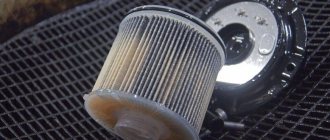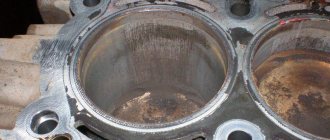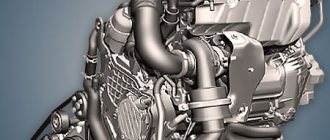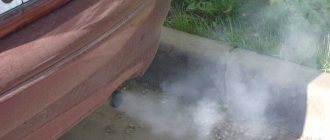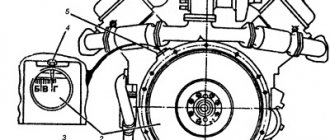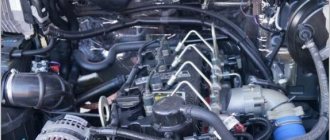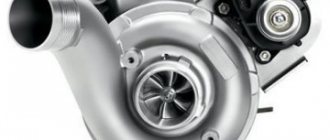Warming up a diesel engine: pros and cons
Each automaker has its own approach to the question of whether it is necessary to warm up a diesel engine.
Foreign car manufacturers that produce diesel power units equipped with a turbine equip them with a modern injection system. It allows you to start moving immediately, since the fuel does not wash away the oil from the surfaces of the liners. This is ensured by the correct implementation of the fuel atomization system. But still, in cold weather, diesel fuel changes its quality characteristics and becomes more viscous. It partially loses its current properties. Therefore, it is necessary to warm up the engine. If we talk about domestic automakers, they recommend starting to drive only after the engine has warmed up to a temperature of 45 degrees.
When this goal is achieved, the movement can begin. Warming up a diesel engine has certain advantages. It is also not without its shortcomings. Therefore, it makes sense to list both.
Main advantages
In addition to the disadvantages, warming up a diesel engine has certain advantages.
When the diesel power unit warms up, optimal oil distribution occurs. And this leads to less wear and tear on the most important parts of the unit. This is achieved due to the fact that all elements, mechanisms and parts are thoroughly lubricated. As a result, a greater resource is achieved. The motor can operate without major repairs for a longer time.
Another advantage of warming up a diesel engine is that the car, which starts driving after the engine has warmed up, runs more smoothly and the appearance of any jerks is completely eliminated.
Source
Is it worth warming up a diesel engine?
Diesel engine oil has one very unpleasant feature - it thickens. Even winter oil at low temperatures becomes too viscous to serve as a lubricant for components. In addition, thickened oil will cause the engine to not start, since the oil pump has difficulty pumping it.
Not always and not in all engines there is enough oil film to start the system. Also, this film is quickly washed away by the fuel that is supplied to the engine, so there is a risk that the engine will stall after a few minutes of driving without warming up.
To avoid this problem, the engine must be warmed up. At idle, the engine will quickly reach the required temperature and dilute the oil to ensure lubrication of the pistons and cylinders.
Heating the engine oil
The design features of diesel engines, compared to gasoline engines, require reduced gaps that are present between the cylinder wall and the piston. Diesel-fuelled internal combustion engines have a high compression ratio, which also means serious loads on the cylinder-piston group.
Part wear is minimized by engine oil. During the cold season, the lubricant in the engine crankcase thickens. After inactivity, only a small oil film remains on the cylinder walls and surfaces of rubbing parts.
After a cold start, the effective operation of the lubrication system begins from the moment the internal combustion engine reaches operating temperature (the oil finally liquefies, heats up and begins to operate under optimal conditions). Turbocharged diesel engines additionally require a high-quality supply of heated engine oil to lubricate the turbocharger. The resource of a diesel engine turbine directly depends on this. It is logical that the oil needs to be warmed up a little at idle, and when you start driving, do not subject the engine and turbine to loads until they are completely warmed up.
Harmfulness
Warming up a diesel engine is prohibited by law in some states. But it is worth remembering that the emissions of harmful substances from diesel are less than from gasoline. But diesel exhaust will not cause global harm to the environment, but it will easily extend the life of the engine.
Advice! Do not start your journey on a cold engine, or rather, wait until it reaches a temperature of at least 40 degrees. He can catch up with the rest on the way. But still, stick to the minimum value, since the operating temperature is 90 degrees.
Warming up the engine is an integral part of driving a car. In addition, this process does not take much time, which can be spent to benefit yourself and your car. Just don’t warm up your diesel engine under your neighbors’ windows, as it’s at least not polite.
Do you warm up your car engine?
How long? Write comments , like , subscribe to the channel.
Source
What do manufacturers advise?
To the question of whether it is necessary to warm up a diesel engine in winter, manufacturers today give a clear answer - “warming up the internal combustion engine is not required.” It is worth understanding what this statement is based on. Why did the same manufacturers previously advise warming up engines, but now they have suddenly changed their point of view?
Many car engine manufacturers claim that their products are so advanced that they work flawlessly even without warming up. They begin to explain that earlier the engines were primitive, and the oil was mineral, that scientific and technological progress does not stand still. Well, they don’t say about the water that it was wetter.
The theory of warming up a diesel engine in winter
Engines are made of metal. Pistons are usually made of light aluminum alloys, cylinders are made of steel or cast iron. When heated and cooled, these parts expand or contract accordingly. All engine components are precision manufactured to ensure minimal clearance between piston and cylinder. This is the key to efficient use of fuel energy.
When the engine is cold, the clearances between the pistons and cylinders do not correspond to the design parameters. Until the temperature rises to the operating level, the motor does not operate in the mode intended by the manufacturer. If you give full load, the wear of parts will increase, which will lead to a decrease in working life or an accident.
In addition to the thermal expansion factor, there is another problem. Oil viscosity. This parameter greatly affects the operation of the engine. If the lubricant thickens in the cold, it cannot fully lubricate the parts, which leads to an increase in the friction force in all pairs. Wear increases manifold if the engine is running under load.
Obviously, driving with a cold diesel engine is not a good idea. Another question arises: how to warm up a diesel engine in winter . Can this be done at idle? What duration is optimal? Let's figure it out together.
Cylinder piston group and crankshaft
It is worth considering that warming up of a diesel engine is not uniform. Some parts heat up faster, others still remain cold. The internal combustion engine elements are made of metal and aluminum alloys (crankshaft, cylinders, pistons, shafts, etc.). As you know, when heated, the body expands, and the heating time and expansion coefficient depend on the material of manufacture.
It turns out that only after the motor reaches operating temperatures are optimal thermal clearances established and the rubbing pairs are properly lubricated. For this reason, immediate start of movement and additional loads on a cold engine reduce its service life.
Warm to victory
Some car owners believe that the diesel engine must be heated at idle until the coolant temperature rises to 70°C. Another option is until the speed drops to idle. The feasibility of such an approach seems questionable. Let's figure it out.
Due to its design features, a diesel engine heats up less at idle than a gasoline engine, and the whole car warms up worse. To achieve a noticeable increase in temperature in winter , you have to warm up the diesel engine for 30 - 40 minutes. During this time, a noticeable amount of fuel is consumed. For example: a three-liter diesel engine will “burn” approximately 200 ml of fuel during 20 minutes of warming up at idle speed.
Warm, but without fanaticism
Other drivers answer the question “ how to warm up a diesel engine in winter ” briefly and clearly: “wisely.” In their opinion, it is enough to let the engine run for a couple of minutes to warm up the oil in the crankcase, and then start driving. The main thing is not to give the engine full load until its temperature rises to the optimal level. You can monitor this indicator using the coolant sensor.
Proponents of this method of warming up a diesel engine in winter believe that the engine warms up faster while driving. Also, when the car is moving, the transmission and chassis heat up more actively. Everything looks reasonable.
How long does it take to heat a diesel engine in winter?
There are no specific instructions on how long to heat a diesel engine in winter. Do this at idle or while driving. Warming up the engine is not such a tedious and time-consuming task.
While you are clearing snow from your car or warming up the windows, the engine will warm up slightly. And then you can start moving without overloading it too much. The optimal warm-up time for a diesel engine while driving in winter is about 8-10 minutes. This time is enough for the coolant to warm up to 40-50 degrees.
In order to warm up a diesel engine in winter, you need to turn on the ignition and start the engine. Let it run for a bit and then start driving, about 8-10 minutes will be enough at low speeds.
Objectively: how to properly warm up a diesel engine in winter
From a technical point of view, warming up a diesel engine in winter is vital. If you take into account the technical features and mechanics of the vehicle systems, you can figure out how to warm up diesel engines.
At subzero temperatures, the engine should be started with a full supply of fuel. The clutch is depressed. The running engine warms up for two to three minutes. The crankshaft rotation speed rises gradually to medium. When the device shows that the coolant has warmed up to 40°C, it means the engine is ready for loads.
Next, the engine warms up while driving in low gears at low speeds. When the coolant temperature reaches 75°C, you can drive as the road conditions allow.
To make starting a diesel engine easier, you need to turn on the glow plugs several times. These devices are built into the design of modern diesel power units. They help heat the air entering the combustion chamber. In a diesel engine, ignition occurs as a result of heating the highly compressed fuel-air mixture in the cylinder. Heating the air will make starting easier.
What do we get when performing such an algorithm for warming up a diesel engine? In the first two minutes after starting the engine, the oil in the crankcase warms up enough to fully lubricate the cylinder-piston group. A smooth start to movement helps to warm up the transmission lubricant and “develop” the suspension. While driving, the diesel engine warms up faster. Fuel consumption is reduced. After 5 minutes of driving, you can turn on the interior heater, which will speed up the heating of the engine.
From the point of view of the operation of the engine, chassis and other vehicle systems, this method is the most logical. Practical observations show the effectiveness of this method. The gentle starting mode helps protect the diesel engine from breakdown in frosty weather.
Features of diesel engine warming up
In the opinion of many, it is better not to warm up an engine with a turbine while running, precisely because of the turbine, since it turns on only at the required crankshaft speed, which appears at high speed. It is prohibited to develop high speed on a cold engine. Driving with the turbine turned off can lead to overheating of the engine, which will result in overheating of the cylinder heads and their rapid wear.
A diesel engine needs to idle for at least 5 minutes, this is enough for all components to be properly lubricated (if, of course, the glow plugs are in working condition). The developers advise heating the spark plugs twice. When their indicator on the panel turns off, it means that the voltage in them has turned off, although most people think that this happens if the maximum temperature is reached.
How to warm up a diesel engine with a turbine in winter
Recommendations for turbocharged diesel engines are no different from those for atmospheric counterparts. In the same way, you should start the engine, warm it up for a few minutes, and start driving at low speeds in first gear. Warm-up time while driving is about 5 minutes; during this time, use no higher than third gear. Monitor the warming up of the diesel engine using the coolant temperature.
A good result is achieved by using special pre-heaters. It would also be a good idea to make life easier for your engine by using special additives - anti-gels. They prevent diesel fuel from thickening in the cold. Many car owners have difficulty starting diesel engines precisely because of thickened fuel. It is especially difficult in winter if the car is filled with summer diesel fuel.
We tried to give a complete answer to the questions of why and how to warm up a diesel engine in winter . We hope you can draw the right conclusions to protect the “heart” of your car from breakdowns on frosty days.
Source
Why is oil warming necessary?
The functioning of the engine is greatly influenced by the octane number of the fuel assembly, the quality of the fuel, and the presence of additional additives. For easier starting, many use pre-start devices, glow plugs, etc. But still, how effectively diesel injectors will spray fuel depends only on the temperature of the power unit.
If the car has an automatic transmission, then it is necessary to warm up the engine, since the oil in the box must warm up to the required temperature.
In their design, diesel engines differ from gasoline engines, primarily in that their gaps between the piston and cylinder are not so large. A diesel engine has a high compression ratio, which places significant stress on the cylinders and pistons. The rapid wear of these components reduces the oil, which thickens at low air temperatures and requires heating.
Oil for units with a turbine must be supplied with even better quality to lubricate the turbocharged compressor, since the functioning of the turbine itself depends on it. The oil warms up at idle speed; do not overload the engine until it is fully warmed up.
